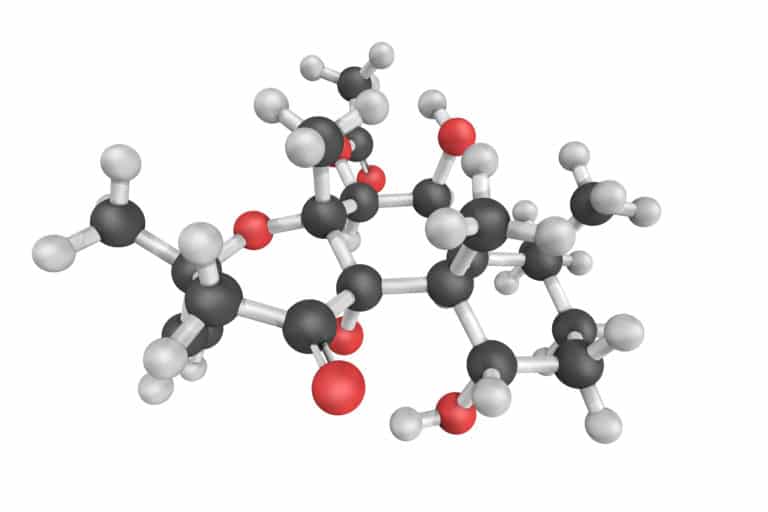Colforsin

The harp shrub Plectranthus barbatus is native to tropical regions of Africa, China, India, and the Arabian Peninsula. It belongs to the labiates family and is a semi-shrub. With its beautiful purple-blue flowers and relatively large foliage leaves, it is extremely attractive to look at. But the peculiarity of the harp shrub lies not only in its appearance. It is the only significant source of a diterpene called colforsin, which is also known as colforsin or forskolin. These terms all refer to the same substance. Naturally, this substance does not occur in the human body.
Diterpenes are generally widespread in the harp shrub genus. However, colforsin is an exception, as it has only been isolated in significant amounts from Plectranthus barbatus. In biochemistry and pharmacology, this substance is intensively used experimentally because it has multiple effects and directly stimulates the enzyme adenylyl cyclase, which is present in almost all living organisms.
Colforsin in medicine
The harp shrub Plectranthus barbatus has a long tradition in Chinese, African and Brazilian folk medicine, as well as in Ayurvedic medicine. It is used to treat heart and nervous diseases, as well as respiratory disorders. Much of its effectiveness is due to the substance colforsin. In basic medical and biochemical research, colforsin is used as a model substance to increase cellular cAMP levels. As a diterpenoid, colforsin has a vasodilatory effect and can lower blood pressure. It has long been debated whether colforsin can be used in the treatment of asthma, heart disease, thrombosis, and obesity. Athletes and bodybuilders use specific plant extracts containing colforsin because they are thought to serve as potential “fat burners.” Although efficacy in relation to these applications has not yet been adequately demonstrated, studies show that oral ingestion of Colforsin can reduce stubborn fat deposits without sacrificing muscle mass.
Colforsin in cosmetics
Natural cosmetics combine the natural active ingredient Colforsin with various tanning substances. In fact, it is able to boost the natural melanin production of our skin even when the sun is not shining. However, since the effect is not very strong, Colforsin cannot be used as the sole tanning substance. Instead, the substance has an impressive effect elsewhere. As already mentioned, it activates adenylate cyclase. This enzyme catalyzes cyclic adenosine monophosphate (cAMP) from ATP. For general and cellular metabolism, cAMP is a very important component. It is normally formed when certain hormones bind to the cell membrane receptor, causing adenylate cyclase to be activated. Colforsin can bypass this hormonal activation. It directly stimulates adenylate cyclase, whereupon cellular cAMP levels increase. Through this remarkable property, Colforsin improves and facilitates the transport of valuable nutrients into the cells of the skin.
Furthermore, the substance provides effective protection against the damaging effects of solar radiation. Using a skin model as well as UVB-irradiated human keratinocytes, it was shown that timely treatment with the active ingredient leads, among other things, to a significant reduction in DNA damage-specific antibodies and also significantly reduces the number of burned cells. Furthermore, there was a reduction in the enzyme that causes DNA breaks (poly [ADP-ribose] polymerase). The protective effect of the compound on DNA was confirmed by a TUNEL test. Scientists now believe that colforsin can protect cells from a process called cell death, apoptosis, by regulating MET and HGF expression.
Colforsin is an excellent active ingredient for combating signs of skin fatigue and tired facial features. Environmental pollution, UV rays, stress and an unbalanced diet usually take their toll on the skin. The complexion becomes sallow and uneven, the entire skin appearance changes negatively. Colforsin protects the skin cells and helps the complexion regain a fresh and vital appearance. In addition, the active ingredient can also be used very well for the treatment of psoriasis and eczema.
The structure of the active ingredient is such that easy penetration into the skin is guaranteed, as is optimal availability in the cells. As a rule, a concentration of 0.1 to 0.5 percent is recommended. A combination with caffeine is particularly suitable for cellulite. The active ingredient is generally very well tolerated. However, to be on the safe side, it should not be used in the case of couperose.
Fact Sheet: Colforsin
CAS number: 66575-29-9
Alternative names: Coleonol, Forskolin
Description: a colorless to yellow solid
Melting point: 230 to 232 degrees Celsius
Solubility: soluble in chloroform, ethanol and DMSO
Fact Sheet:
INCI: Coleus Forskohlii Root Extract and
INCI: Coleus Barbatus Root Extract
CAS number: 223748-52-5
We like to work with the following Coleonol-containing agents:
| Trade Name | Company | INCI | Comment |
|---|---|---|---|
| Coleus Forskohlii Oil | Sabinsa Europe GmbH | Coleus Forskohlii Root Oil | |
| Coleus Forskohlii Extract | Pharma Base S.A. | Coleus Forskohlii Root Extract | |
| Coleus Forskohlii Extract 95% | Sabinsa Europe GmbH | Coleus Forskohlii Root Extract | |
| Sensfeel | Provital | Propanediol, Coleus Forskohlii Root Extract, Camellia Sinensis Leaf Extract | |
| ForsLean 98% | Sabinsa Europe GmbH | Coleus Barbatus Root Extract | |
| ViaPure Coleus | Gfn-Selco | Coleus Barbatus Root Extract | |
| COSMELENE OF COLEUS | Greentech | Butylene Glycol, Aqua, Coleus Barbatus Root Extract | |
| ProContour | Evonik – Personal Care | Water, Alcohol, Lecithin, Caffeine, Carnitine, Centella Asiatica Leaf Extract, Potassium Phosphate, Coleus Barbatus Root Extract |
An exceptional active ingredient with many advantages
Colforsin can be used in a wide variety of ways in (dermatological) cosmetics. The modes of action can basically be divided into three categories: Melanocytes and pigmentation promotion, keratinocytes and anti-inflammatory modulation, and adipocytes and lysis of accumulated triglycerides. Cosmacon will be happy to develop for you modern and innovative cosmetics with the active ingredient from the harp shrub.
Sources: